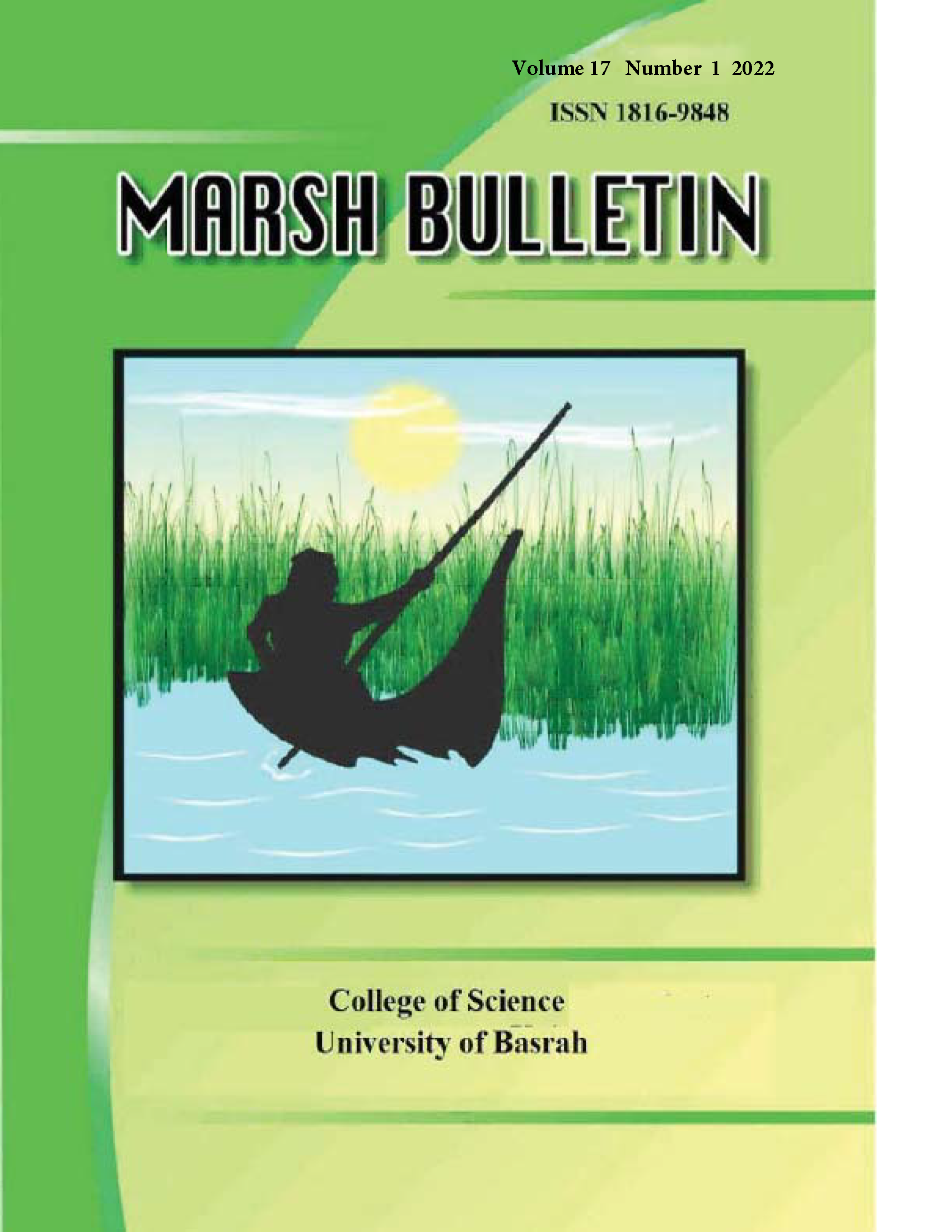Abstract
Recent years, the problem of high salt concentrations in the Shatt al-Arab river repeated affecting
directly on the human water uses, ecology, and agricultural activity of these regions. The study area was
located at the lower part of the Mesopotamian Basin. Five stations were selected for measuring the salinity
and water level. These stations were Hareer on Al-Sallal waterway, Al-Mas`hab on the Al-Mas`hab
waterway, Garmah Bridge near on Garmah waterway, Haritha, and Maqal stations on Shatt Al-Arab
River. The measurements were taken for salinity and water level over 30-day period for two season
(winter, summer). It was measured synchronizing with the days of spring and neap tide during February
and July months. Landsat 8 imagery, Operational Land Imager (OLI) sensor are acquired from USGS for
the study area, in order to monitor and map salt features. The spatial distribution of salinity was drawn
using geostatistical interpolation technique (kriging approach) in ArcGIS 10.1. The study revealed that
water of Mas`hab and Al-Sallal entering Garmah waterways then Shatt Al-Arab river during ebb-tide
period were negatively affected on water quality of Shatt Al-Arab, because of increasing of salinity
concentrations. This study suggested a way to avoid the effects of Mas`hab and Al-Sallal waterways on the
water quality of Shatt Al-Arab river.
directly on the human water uses, ecology, and agricultural activity of these regions. The study area was
located at the lower part of the Mesopotamian Basin. Five stations were selected for measuring the salinity
and water level. These stations were Hareer on Al-Sallal waterway, Al-Mas`hab on the Al-Mas`hab
waterway, Garmah Bridge near on Garmah waterway, Haritha, and Maqal stations on Shatt Al-Arab
River. The measurements were taken for salinity and water level over 30-day period for two season
(winter, summer). It was measured synchronizing with the days of spring and neap tide during February
and July months. Landsat 8 imagery, Operational Land Imager (OLI) sensor are acquired from USGS for
the study area, in order to monitor and map salt features. The spatial distribution of salinity was drawn
using geostatistical interpolation technique (kriging approach) in ArcGIS 10.1. The study revealed that
water of Mas`hab and Al-Sallal entering Garmah waterways then Shatt Al-Arab river during ebb-tide
period were negatively affected on water quality of Shatt Al-Arab, because of increasing of salinity
concentrations. This study suggested a way to avoid the effects of Mas`hab and Al-Sallal waterways on the
water quality of Shatt Al-Arab river.
Abstract
تكررت في السنوات االخيرة مشكلة ارتفاع التراكيز الملحية في مياه شط العرب مما اثر بشكل مباشر على الواقع الحياتي و الصحي
والنشاط الزراعي لهذه المناطق. تقع منطقة الدراسة في الجزء األدنى من حوض وادي الرافدين. تم أختيار خمس محطات لقياس نوعية
المياه ومستوى عمود الماء هي حرير على نهر الصالل والمسحب على نهر المسحب وجسر الكرمة على نهر الكرمة ومحطة الهارثة
ومحطة المعقل على شط العرب. أخذت القياسات بواقع قراءة للملوحة ولمستوى عمود الماء كل ساعة ولجميع المحطات على مدى 03 يوم
للموسمين الشتوي والصيفي ولشهري شباط وتموز متزامنة مع أيام المد الربيعي والمد المحاقي في هذه األشهر. استخدمت جزء من بيانات
القمر الصناعي الندسات8- من موقع USGS لتغطية منطقة الدراسة ورسم خرائط لمراقبة األمالح. رسم التوزيع المكاني لألمالح
بواسطة تقنيات interpolation geostatistical بطريقة )approach kriging )في برنامج 10.1 ArcGIS. توصلت الدراسة
إلى أن المياه الخارجة من جدولي المسحب والصالل الى شط الكرمة ومنه الى شط العرب خالل عملية الجزر تؤثر سلبيا على نوعية مياه شط العرب حيث تسبب زيادة تراكيز االمالح. قدمت الدراسة الحالية حلوال لتفادي مشكلة نوعية مياه جدولي المسحب والصالل وتأثيرهماعلى نوعية المياه في شط الكرمة ومن ثم شط العرب
والنشاط الزراعي لهذه المناطق. تقع منطقة الدراسة في الجزء األدنى من حوض وادي الرافدين. تم أختيار خمس محطات لقياس نوعية
المياه ومستوى عمود الماء هي حرير على نهر الصالل والمسحب على نهر المسحب وجسر الكرمة على نهر الكرمة ومحطة الهارثة
ومحطة المعقل على شط العرب. أخذت القياسات بواقع قراءة للملوحة ولمستوى عمود الماء كل ساعة ولجميع المحطات على مدى 03 يوم
للموسمين الشتوي والصيفي ولشهري شباط وتموز متزامنة مع أيام المد الربيعي والمد المحاقي في هذه األشهر. استخدمت جزء من بيانات
القمر الصناعي الندسات8- من موقع USGS لتغطية منطقة الدراسة ورسم خرائط لمراقبة األمالح. رسم التوزيع المكاني لألمالح
بواسطة تقنيات interpolation geostatistical بطريقة )approach kriging )في برنامج 10.1 ArcGIS. توصلت الدراسة
إلى أن المياه الخارجة من جدولي المسحب والصالل الى شط الكرمة ومنه الى شط العرب خالل عملية الجزر تؤثر سلبيا على نوعية مياه شط العرب حيث تسبب زيادة تراكيز االمالح. قدمت الدراسة الحالية حلوال لتفادي مشكلة نوعية مياه جدولي المسحب والصالل وتأثيرهماعلى نوعية المياه في شط الكرمة ومن ثم شط العرب
